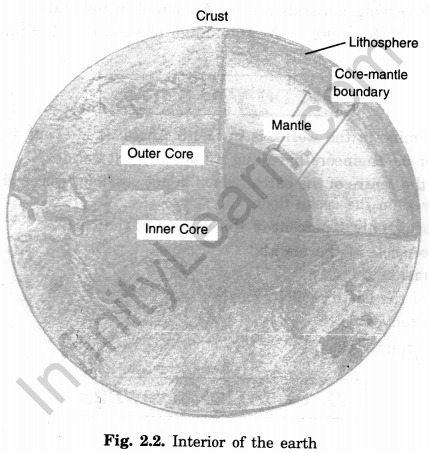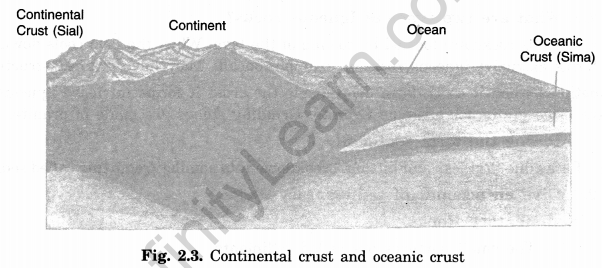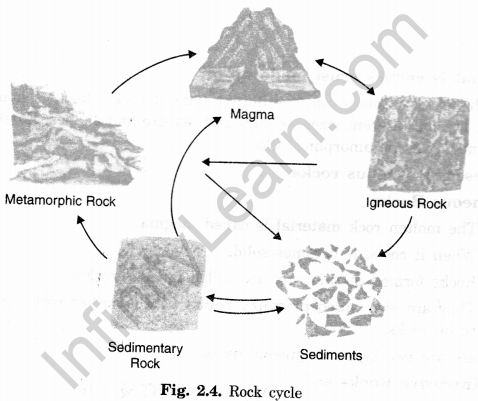Table of Contents
Inside Our Earth Class 7 Extra Questions Social Science Geography Chapter 2
Inside Our Earth, Chapter 2 from the Class 7 Social Science Geography CBSE syllabus, get into the structure of our planet. To help students deepen their understanding of this complex topic, we offer a set of extra questions and answers, including multiple-choice questions (MCQs) and short answer queries. These supplementary resources, aligned with NCERT and CBSE standards, are specifically designed to enhance learning and test comprehension, making them ideal for students preparing for exams and teachers enriching their classroom materials.
Class 7 Food Inside Our Earth Extra Questions with Answers
Below are the Inside Our Earth extra questions with answers from outside NCERT textbook for deepen the concepts.
NCERT Extra Questions for Class 7 Social Science Geography Chapter 2 Inside Our Earth
Here are long and short Inside Our Earth Class 7 extra questions Social Science Geography chapter 2
Extra Questions of Inside Our Earth Class 7
Question 1. How does the earth exhibit dynamism?
Answer: The earth, our home, showcases dynamism as it perpetually undergoes transformations both internally and externally.
Interior of the Earth – Extra Questions of Inside Our Earth Class 7
Question 1. Have you ever pondered about the secrets held within the earth’s core and its composition? What materials form the essence of the earth?
Answer: Yes, indeed. The earth’s interior reveals three distinct layers consisting of rocks of varying densities, constituting the fundamental structure of our planet.
Question 2. Elaborate on the structure of the earth’s interior.
Answer: Interior of the Earth: The earth boasts a stratified composition akin to an onion, comprising several concentric layers.
Crust:
The outermost layer, known as the crust, blankets the earth’s surface. It embodies the thinnest layer among all, approximately 35 km thick over continents and merely 5 km thick beneath oceans. The principal mineral components of continental crust are silica and alumina, hence termed as sial (si – silica and al – alumina).

- The oceanic crust mainly consists of silica and magnesium.
- It is therefore called sima (si – silica and ma – magnesium).

- Mantle:
- Situated directly beneath the crust lies the mantle.
- It spans a depth of approximately 2900 km below the crust.
- Core:
- At the deepest level is the core, boasting a radius of around 3500 km.
- Comprised predominantly of nickel and iron, it earns the name nife (ni—nickel and fe—ferrous, meaning iron).
- The central core experiences exceptionally high temperatures and pressures.
Rocks and Minerals – Extra Questions of Inside Our Earth Class 7
Question 1.
What is earth’s crust made up of?
Answer:
The Earth’s crust consists of various rocks. Rocks are naturally occurring masses composed of mineral matter and come in diverse sizes, colors, textures, and shapes. The primary types of rocks found in Earth’s crust are sedimentary, igneous, and metamorphic rocks.
Question 2.
Describe igneous rocks.
Answer:
Igneous Rocks
- Magma is the term for molten rock material.
- Upon cooling, this material solidifies.
- Rocks formed through this process are known as igneous rocks, often referred to as primary rocks because they are the origin for other rock types.
Types of Igneous Rocks:
- Intrusive Rocks and Extrusive Rocks
Formation of Extrusive and Intrusive Rocks:
- The core heat of the earth melts rocks into magma.
- When magma surfaces, it solidifies into extrusive rocks.
Example: Basalt, notably in the Deccan Trap. - Intrusive rocks form when magma cools and solidifies within the Earth.
Examples: Granite, Garbo
Question 3.
What is lava?
Answer:
Lava is magma that has erupted onto the Earth’s surface from its interior. It cools and solidifies upon exposure to the environment.
Question 4.
What are two types of Igneous rocks?
Answer:
Igneous rocks are classified based on the cooling location of the lava:
- Extrusive igneous rocks form when lava cools on the surface, such as basalt, which typically has a fine-grained structure.
- Intrusive igneous rocks form when magma cools deep within the Earth, resulting in large-grained rocks like granite, commonly used in grinding stones.
Question 5.
Define the term sediment.
Answer:
Sediments are smaller fragments resulting from the breakdown of rocks through natural processes like cracking and impacts.
Question 6.
Give an account of sedimentary rocks.
Answer:
Sedimentary Rocks
- Sediments are small particles.
- These particles are carried and deposited by agents like wind and water into lower areas.
- Over time, these sediments compress and harden, forming layered rocks known as sedimentary rocks.
Example: Sandstone, which often contains fossils of plants, animals, and micro-organisms.

Question 7.
What are Fossils?
Answer:
Fossils are the preserved remains of ancient plants and animals that were encapsulated within rock layers.
Question 8.
How are metamorphic rocks formed?
Answer:
Metamorphic Rocks:
- Under intense heat and pressure, both igneous and sedimentary rocks transform into metamorphic rocks, forming more precious and structurally different rocks.
Examples: Granite into granite gneiss, coal into slate, slate into schist, limestone into marble.
Limestone transforms into marble due to intense pressure from overlying layers and increasing heat from the Earth’s interior.
Question 9.
What are the uses of rocks?
Answer:
Uses of Rocks:
- Construction materials for buildings and barrages.
- Commonly used stones include granite, marble, and slate.
- Used in games such as:
- Seven stones (phitthoo).
- Hop scotch (stapu, kit kit).
- Five stones (gitti).
- Utilized in infrastructure such as bridges and embankments.
Question 10.
Briefly describe the ‘rock cycle’.
Answer:
The rock cycle is a continuous process where one rock type converts into another:
- Molten magma solidifies to form igneous rocks.
- These rocks break down into sediments that form sedimentary rocks under compression.
- Both rock types can become metamorphic rocks under heat and pressure.
- These metamorphic rocks can melt again to become magma, continuing the cycle.
Question 11.
What are minerals? How are minerals important to us?
Answer:
Minerals:
- Minerals are naturally occurring substances with specific physical properties and a definite chemical composition, found in rocks.
- Minerals are crucial for various applications:
- As fuels (e.g., coal, natural gas, petroleum).
- In industries as raw materials (e.g., iron, aluminum, gold, uranium).
- In medicine and fertilizers.
- Chapter 1 Environment
- Chapter 2 Inside Our Earth
- Chapter 3 Our Changing Earth
- Chapter 4 Air
- Chapter 5 Water
- Chapter 6 Natural Vegetation and Wildlife
- Chapter 7 Human-Environment – Settlement, Transport, and Communication
- Chapter 8 Human-Environment Interactions The Tropical and the Subtropical Region
- Chapter 9 Life in the Deserts
Inside Our Earth Objective Type Questions
Question 1.
Fill in the blanks with appropriate words:
- Lava is the molten magma from ……………………… of the earth’s surface.
- Like a ………………………, the earth is made up of ……………………… layers.
- Crust is about ……………………… km on the continental mass and ……………………… km on the
ocean floor. - Mantle forms about ……………………… of the earth’s volume.
- Core has a radius of about ……………………… km and has very high temperature and ………………………
- Limestone under excessive heat and pressure changes into ………………………
Answer:
- Lava is the molten magma from the interior of the earth’s surface.
- Like a onion, the earth is made up of concentric layers.
- Crust is about 35 km on the continental mass and 5 km on the ocean floor.
- Mantle forms about 16% of the earth’s volume.
- Core has a radius of about 3500 km and has very high temperature and pressure.
- Limestone under excessive heat and pressure changes into marble.
Question 2.
State whether the given statements are true or false:
- Crust is the thickest of all the layers.
- Core is the innermost layer of the earth.
- Mantle extends up to the depth of 2900 km.
- The loose sediments are hardened to form metamorphic rocks.
- Deccan plateau is made up of basalt.
- Fossils are remains of dead plants and animals.
Answer:
- False
- True
- True
- False
- True
- True
Question 3.
Match the contents of Column A with that of Column B.

Answer:
1. (d)
2. (e)
3. (f)
4. (d)
5. (b)
6. (c).
Inside Our Earth Class 7 Extra Questions and Answers MCQ (Multiple Choice Questions)
Question 1. Where is the deepest mine in the world located?
- South America
- South Africa
- South India
- South Australia
Answer:
(b) South Africa
Question 2.
The depth of the deepest mine in South Africa is
- one km
- two km
- three km
- four km
Answer:
(c) four km
Interior of the Earth MCQs Class 7
Question 1. The upper most layer of the earth’s surface is called
- the crust
- the brust
- the roads
- the forest
Answer:
(c) the roads
Question 2. What is the radius of the earth?
- 3671 km
- 7163 km
- 6371 km
- 1736 km
Answer:
(c) 6371 km
Rocks and Minerals MCQs Class 7
Question 1. Any natural mass of mineral matter that makes up the earth’s crust is called a
- rock
- road
- sediment
- none of these
Answer:
(a) rock
Question 2. The sediments are transported and deposited by
- wind
- water
- wind and water
- none of these
Answer:
(c) wind and water
Question 3. The process of transformation of the rock from one form to another is known as
- road cycle
- food cycle
- rock cycle
- all of these
Answer:
(c) rock cycle
Question 4. Which rock is the molten magma made up of?
- Igneous
- Metamorphic
- Sedimentary
- None of these
Answer:
(a) Igneous
Question 5. What is the latin term of Igneous?
- Ignis
- Sedimentum
- Metamorphose
- None of these
Answer:
(a) Ignis
Question 6. Rocks which contain fossils are called
- metamorphic rocks
- igneous rocks
- core
- sedimentary rocks
Answer:
(d) sedimentary rocks
| Other Study Resources for Class 7 | |
| NCERT Solutions for Class 7 | Worksheets for Class 7 |
| NCERT Textbooks for Class 7 | NCERT Exemplar Solutions Class 7 |
FAQs on Extra Questions of Inside Our Earth Class 7
Why Choose Infinity Learn for Inside Our Earth Class 7 Extra Questions?
Choosing Infinity Learn for Class 7's Inside Our Earth extra questions offers detailed explanations and interactive resources that simplify complex geographical concepts, enhancing your understanding and performance in exams.
What is Lava Class 7 Short Answer?
In Class 7 geography, lava is the molten rock that erupts onto Earth's surface from a volcano. It becomes solid as it cools, forming various types of volcanic rock.
Why is Lava Called Magma?
Lava is called magma when it is located beneath the Earth's surface. Magma refers to the molten rock that has not yet erupted from a volcano.
On Which Layer Do We Live?
We live on the Earth's outermost layer, known as the crust. It is the solid rock surface that forms the continents and ocean floors.








